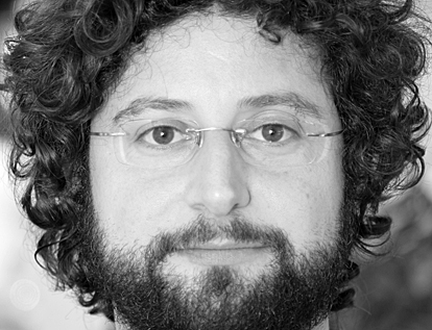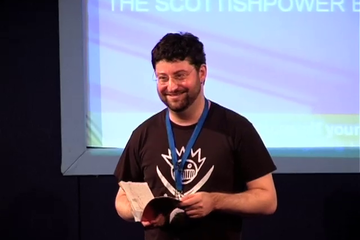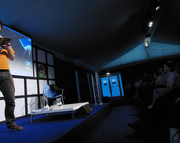Welcome to Flaxland
By Andy Stanton
We have commissioned a new piece of writing from fifty leading authors on the theme of 'Elsewhere' - read on for Andy Stanton's contribution.
WELCOME TO FLAXLAND!
Flaxland! The very name conjures up images of romantic midnight trysts, tiny state-subsidised oranges, and somebody saying ‘Flaxland’. If it’s colourful hustle and bustle you’re after then look no further than the many historic market towns which litter the interior like so many undiscovered trinkets. If magnificent architecture, ancient tombs and follies are more your style then an embarrassment of riches awaits. Or perhaps you’d just like to relax in a big pool, safe in the knowledge that a hamburger is making its way to you on a trolley. Whatever it is that you seek, nowhere does the paradox of culture, art, the grindstone of tradition meeting the dynamic impetus for communication, is better and more clearly expressed than in this ‘country of changes’.
HISTORY
Originally a trading post for monks selling relics (e.g. bone of saint, piece of one true cross, sandal) and fruit (e.g. melon), Flaxland’s centralised position and extensive network of bushes soon made it clear that it would be a nice place to live, not only for monks but for normal people too. In 1302 the first settlers arrived and built a house of wood. This house still survives today, in the sense that its atoms exist somewhere in the universe. Sadly the house itself is long gone. Indeed, it is probable that there was not even a house to begin with.
The first settlers were known as ‘El Ninos Tarangeos’, or ‘the Fat Men from the South’. Realising that the key to their success lay in the rich fertile soil of the region, they carted it away bit by bit to be sold on at a quick profit to neighbouring states. As a result of this, the land rapidly became arid and has remained largely unsuitable for farming ever since. In all respects, life in the fourteenth century was harsh and unforgiving: of the two hundred and forty men, women and children who originally came to the settlement, not a single one is alive today.
In 1360, King Carlos XIICMXCLXII of Catalonia visited the fledgling country and wrote of it:
It is a mean sort of a place, dispiriting and distasteful to the senses. If I had to rate it on a scale of one to ten, where one is not very fetid and ten is extremely fetid, I should probably give it an eight.
However, he later revised his poor opinion, giving it a nine.
Until the end of the sixteenth century Flaxland was a feudal state, ruled over by an elite group of barons and princes who enjoyed a life of carefree idleness while their serfs laboured thanklessly on the land. But the Renaissance was to change all that. Now the barons and princes enjoyed a life working on paintings and classical statues while their serfs laboured thanklessly on the land.
For Flaxland, the Renaissance was truly an age of wonders, of things that had not been heretofore witnessed being envisaged in the mind’s eye and then painted with bristles on canvas stretched upon the easel of progress, the word made flesh in a collective easing of the imaginative bowel that rained down upon the internal landscape of the nation like a cleansing brown rain.
One of the most famous paintings from the period is Giuverchi’s El Ninos Tarangeos (‘Adonis in the Forest’), which now hangs in the Flaxland National Gallery. It is superb, most of the trees are more or less the right sort of shape. Other well-known works of the Flaxonian Renaissance include a sculpture of Adam and Eve, a painting of the sculpture and a sculpture of the painting of the sculpture which one modern commentator has called ‘mindless’.
The fashion for art and gentle reflection was not to last. In 1730 the nation’s paintbrushes were swapped for swords: the Flaxland Civil War had begun, exactly as predicted by the great seer Streptococcus two days earlier. It was to rage for nearly twenty years, an almost unimaginable length of time. To put it into context, that is almost 631,138,519 seconds; or as long as sixteen dozen double-decker buses. The death toll was tremendous. It was so awful that some people actually died twice.
Early on in the conflict, the King was deposed by an angry mob and fled to northern France. However, he was not yet beaten. Becoming a carpenter, he fashioned tables with deliberately uneven legs, and began exporting them back to his home country in a slow but persistent campaign against his detractors. This ruse eventually bore fruit: finding that their plans and charts would not stay put on the lop-sided table tops, the revolutionaries were forced to concede defeat. They had been thwarted, and in 1719 the King rode back home to reclaim his crown, bringing the whole unfortunate episode to an end. Gradually the country returned to everyday life – but its people had suffered much and a certain innocence had been lost forever. A war memorial in the shape of a dancing clown was erected in Parliament Square, symbolising the bitterness of conflict. It still stands there today, a poignant reminder of a tragic time.
After that, nothing much happened for a couple of hundred years.
FLAXLAND LORE AND LEGEND
It is often said of Flaxland that it is a magical place and nowhere is this truer than in the many caves and grottos that honeycomb the north-east coast. Mile for mile these geological marvels contain more apparitions than anywhere else on earth. Of course, not all of the phantoms are benevolent; some are downright menacing. But overall they are a friendly lot and should a traveller find himself stranded she will often be taken in for the night and treated to spectacular displays of phosphorescent emanations and necromancy.
The most famous of all the cave’s supernatural residents is El Ninos Tarangeos (literally, ‘the Inside-Out Soldier’), whose ghastly appearance is belied by his gentle nature and knowledge of the local flora. But don’t be fooled by his gentle nature and knowledge of the local flora – one false move and you’ll be dead, yet another victim of his snapping teeth. Also, some of the caves are poisonous. No, all of them.
For centuries, Flaxland was terrorised by witches who used the country as a convenient stopping-off point on their long annual migrations. Souring milk, unsouring sour cream and wreaking absolute havoc on the cheeses of the region, it seemed impossible to stop these pests. However, in 1873 a solution was found in the form of a small placard placed in a field:
Please do not come here if you are a witch.
Ever since then Flaxland has been witch-free, a fact of which it is justifiably proud. As for other marvellous creatures, the evidence is scant at best. Rumours persist of microscopic giants in the western marches but at the time of writing these remain unconfirmed. Many of the smaller villages have reported ‘anti-vampires’, strange creatures said to pump domestic animals and livestock full of blood and vitamin supplements; but the people here are very superstitious and these entities may in fact be nothing more than common vets.
ENTERTAINMENT & NIGHTLIFE
None.
CUISINE
The national dish is ‘El Ninos Tarangeos’, or ‘the Plate of Beasts’. Typically this is served in a large ceramic tureen and will contain a smorgasbord of good local meats: wild rabbit, goat, hell-fly, chicken, beef and pork are most usual. The dish varies according to region and setting. In an expensive restaurant you might find it supplemented with fish roe, venison and smoked ham; in a small mountain cantina it will be often be garnished with any old crap they can get hold of. As the dish is enjoyed by all levels of society it is sometimes referred to as ‘El Ninos Tarangeos’ (‘The Ladder That Connects Us All’).
Seafood is fresh and plentiful. Take care with oysters as some will literally burst into flame when tackled. The native species of crab is not recommended as it is capable of reincarnating in your stomach and exacting a stormy vengeance. Dory, tuna and marlin are all good. If you know the right people you can get whale meat.
Nuts, seeds and berries are known but frowned upon. Tea is gritty and sweet, and will contain either a fragment of Rubik’s Cube or a swathe of Velcro, depending on who is in power. Fleshy and delectable, the local strain of melon dates back to the days of the monks and is an absolute must.
One peculiarity of Flaxland dining is that restaurateurs will often require you to stand at the base of a high wall while they lower your food into your mouth on lengths of string. Additionally, it is considered de rigueur for children to pay the bill.
The Flaxonian attitude to vegetarians is complex. In some parts of the country vegetarianism is viewed as a mild perversion, akin to cross-dressing or licking the inside of a freezer. Having said this, chefs are by and large tolerant and will usually endeavour to rustle something up in a pinch. Vegans are not allowed into the country under any circumstances.
One word of warning: on no account try the local strain of melon.
GETTING AROUND, CURRENCY, COMMUNICATIONS
In Flaxland there is a saying: ‘You either go by car, train, bus, boat, plane, bicycle, motorbike, jet ski, hovercraft, walk or get around some other way.’ Public transport is cheap but can be notoriously unreliable. Flaxonian bus drivers are absolutely fascinated by new experiences and exist in a state of wide-eyed wonder at the world, frequently driving their vehicles off cliff-tops for the thrill of it or stopping en route to perform impromptu drum solos lasting deep into the early hours. Trains are a safer bet but can be somewhat gassy. Hitchhiking is not a good idea as, under state law, anyone getting into a private vehicle becomes the lifelong property of the vehicle’s owner.
Since 2006, the national currency is the Euro. As a rule of thumb one Flaxonian Euro is worth about 0.8 Euros. Be prepared to barter for goods and services, sometimes for days. Running out of shops clutching items you haven’t paid for is a definite no-no.
Telephone calls in Flaxland are charged according to the distance between the two parties, so if you are making a long-distance call it will pay to walk a few miles up the road first. Be aware that the government intercepts all emails and that they will often change some of your words and phrases for a joke; many is the visitor to Flaxland who has returned to their homeland to be asked what they meant by ‘that remark about the elephant and the priest’. In the event of an emergency the nearest British Consulate is located in Lisbon.
So there you have it! We wish you all the very best during your stay and hope you enjoy your time here in this fascinating and enchanting place. To paraphrase Bastiferus, the country’s greatest living writer (1830-1892):
All of life is… here… in the… place where… it… floater… cross of Jesus… is… not decided… rake.
A world of wonders awaits. Welcome to ‘Europe’s hidden jewel’. Welcome to Flaxland!
SOME USEFUL PHRASES
Hello – Nistra
Goodbye – Nistraa
Please – Nistraaa
Thank you – Nistraaaa
Cement mixer – El Ninos Tarangeos
Copyright © 2010, Andy Stanton. All rights reserved.
Supported through the Scottish Government’s Edinburgh Festivals Expo Fund.
- 2026 Festival:
- 15-30 August
Latest News
 Major new partnership with Celtic Connections
Major new partnership with Celtic Connections








